Abstract
OBJECTIVES--To compare characteristics of syphilis serological reactivity in HIV positive (+) and HIV negative (-) female sex workers, as well as the serological response to therapy after treatment with intramuscular benzathine penicillin, 2.4 million U weekly, for three consecutive weeks. METHODS--Rapid plasma reagin (RPR) and Treponema pallidum haemagglutination assay (TPHA) results of 72 HIV-positive and 121 HIV-negative women reactive in both tests were assessed. The response to therapy was prospectively monitored with quantitative RPR serology in 47 HIV-positive and 73 HIV-negative patients. Cumulative probabilities of becoming nonreactive by RPR were compared at six months, one and two years after therapy. RESULTS--At enrolment, the geometric mean titres of RPR and TPHA were lower in HIV-positive patients (RPR, 1:2.6) than in HIV-negative patients (RPR, 1:3.8; p < 0.01). The evolution over time of RPR titres was similar among HIV-positive patients as compared to HIV-negative patients. Among patients with an initial RPR titre of < 1:8, 53% of HIV-positive and 44% of HIV-negative patients became RPR negative two years after therapy. Among patients with an RPR titre of 1:8 or greater at enrolment, 83% of HIV-positive and 90% of HIV-negative patients had reached at least a fourfold decline of RPR titres two years after therapy. CONCLUSIONS--Syphilis serology findings (both RPR and TPHA) may be altered in the presence of HIV infection, but the serological response to therapy was similar in HIV-positive and HIV-negative patients.
Full text
PDF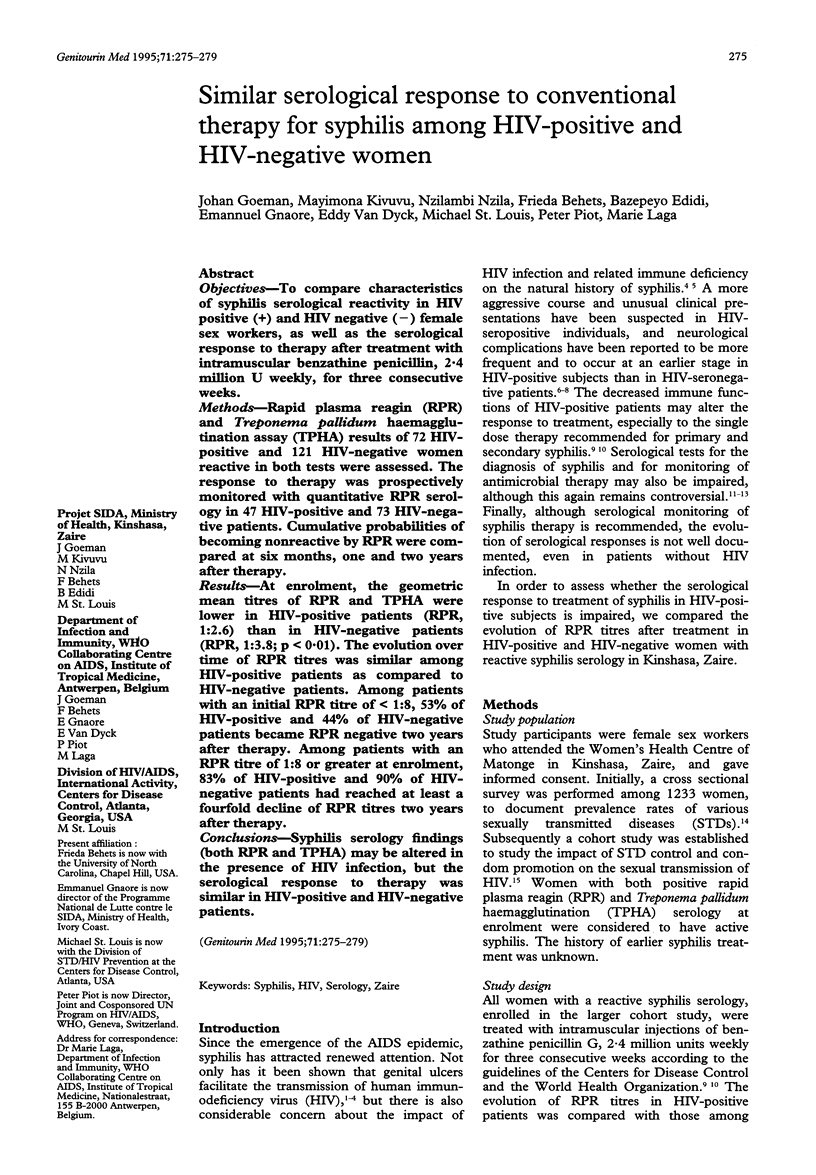
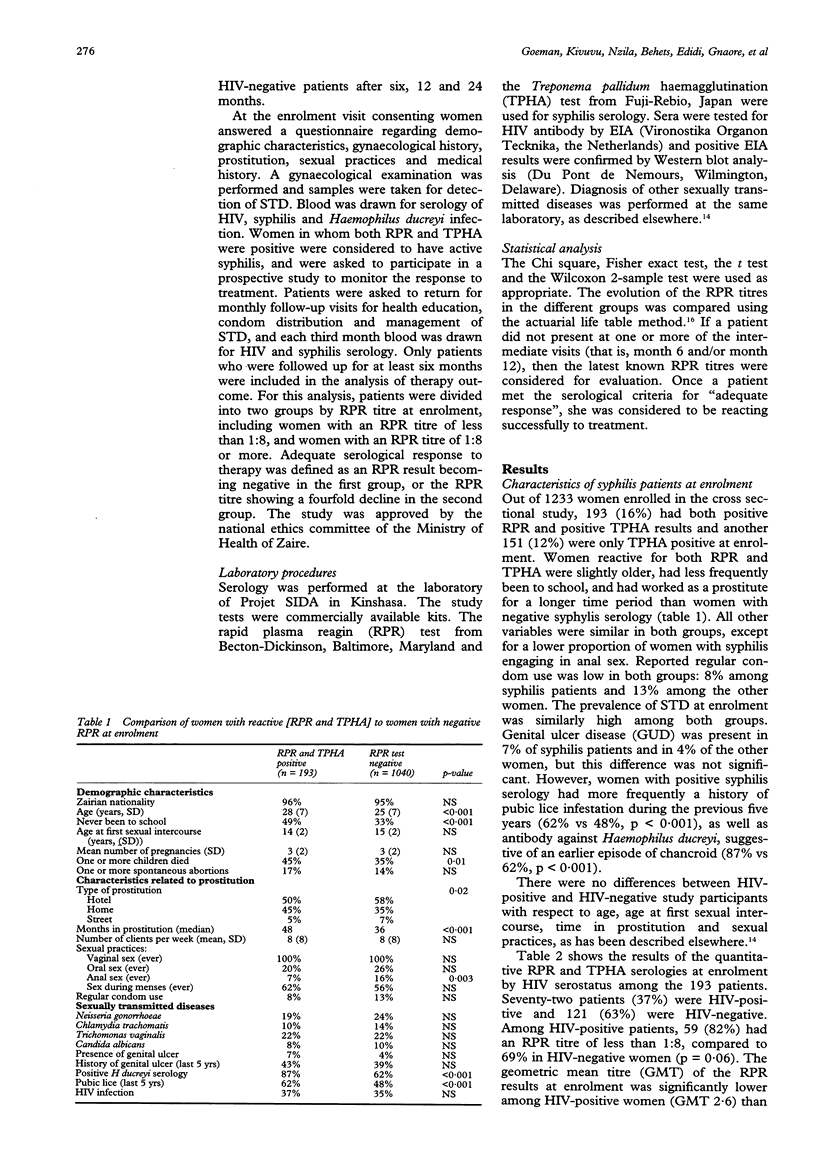
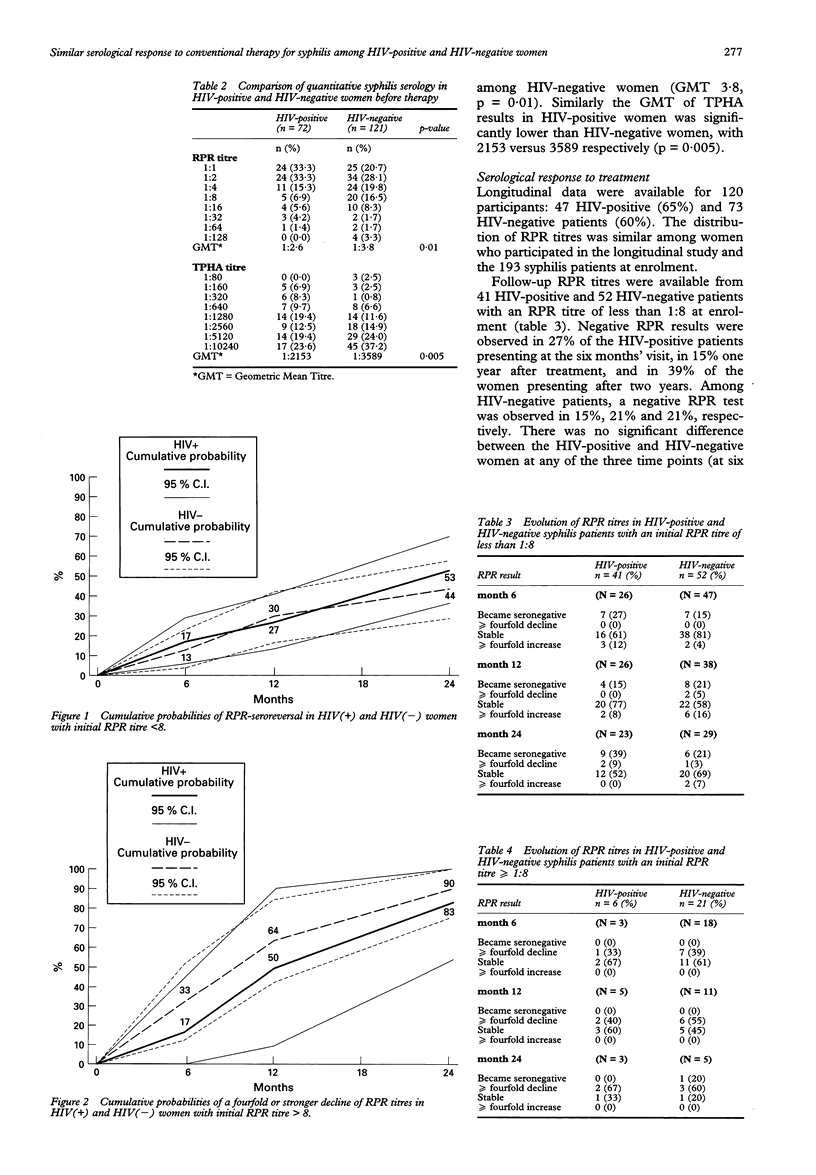
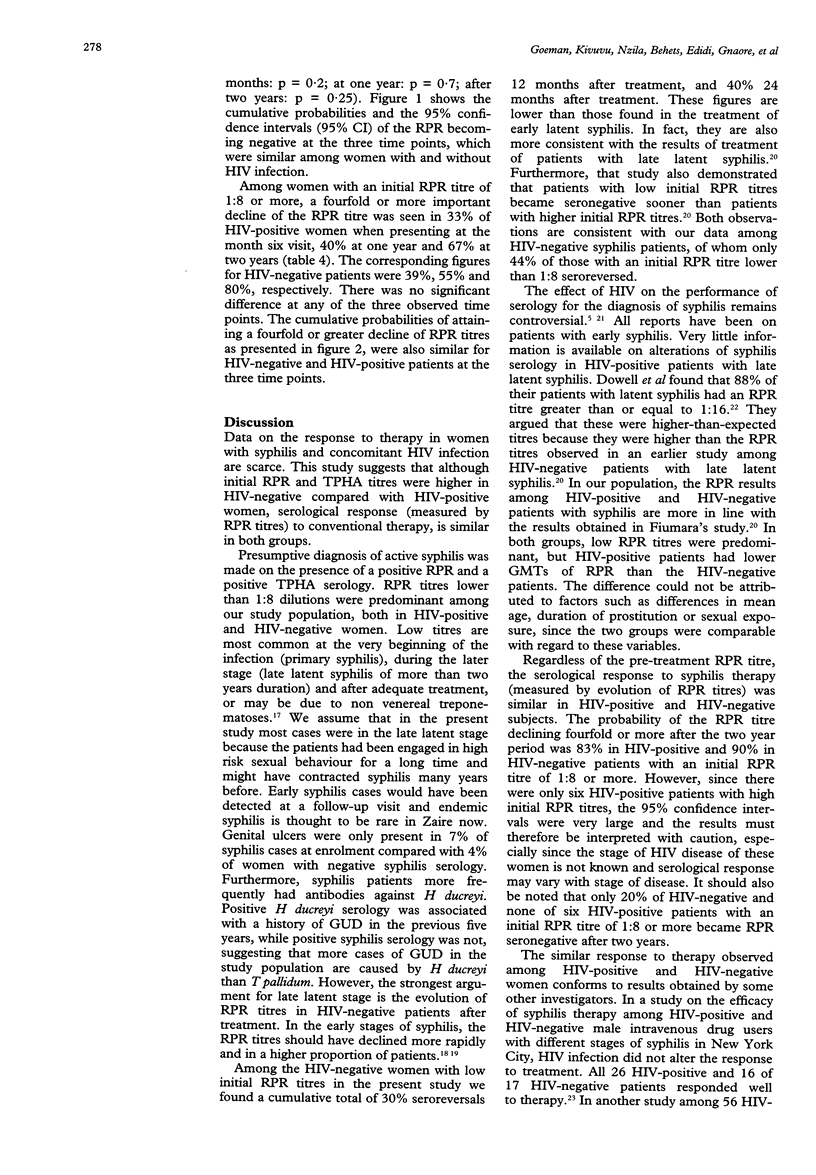
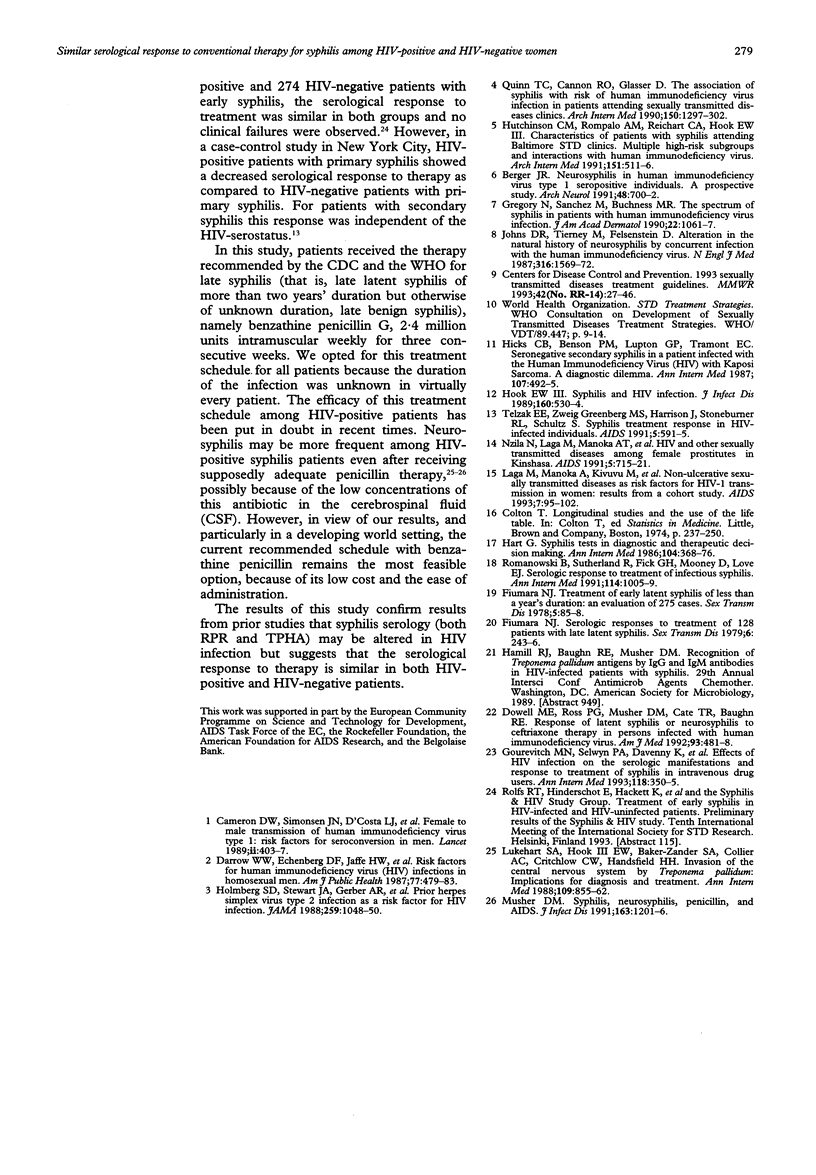
Selected References
These references are in PubMed. This may not be the complete list of references from this article.
- Berger J. R. Neurosyphilis in human immunodeficiency virus type 1-seropositive individuals. A prospective study. Arch Neurol. 1991 Jul;48(7):700–702. doi: 10.1001/archneur.1991.00530190046014. [DOI] [PubMed] [Google Scholar]
- Cameron D. W., Simonsen J. N., D'Costa L. J., Ronald A. R., Maitha G. M., Gakinya M. N., Cheang M., Ndinya-Achola J. O., Piot P., Brunham R. C. Female to male transmission of human immunodeficiency virus type 1: risk factors for seroconversion in men. Lancet. 1989 Aug 19;2(8660):403–407. doi: 10.1016/s0140-6736(89)90589-8. [DOI] [PubMed] [Google Scholar]
- Darrow W. W., Echenberg D. F., Jaffe H. W., O'Malley P. M., Byers R. H., Getchell J. P., Curran J. W. Risk factors for human immunodeficiency virus (HIV) infections in homosexual men. Am J Public Health. 1987 Apr;77(4):479–483. doi: 10.2105/ajph.77.4.479. [DOI] [PMC free article] [PubMed] [Google Scholar]
- Dowell M. E., Ross P. G., Musher D. M., Cate T. R., Baughn R. E. Response of latent syphilis or neurosyphilis to ceftriaxone therapy in persons infected with human immunodeficiency virus. Am J Med. 1992 Nov;93(5):481–488. doi: 10.1016/0002-9343(92)90574-u. [DOI] [PubMed] [Google Scholar]
- Fiumara N. J. Serologic responses to treatment of 128 patients with late latent syphilis. Sex Transm Dis. 1979 Oct-Dec;6(4):243–246. doi: 10.1097/00007435-197910000-00003. [DOI] [PubMed] [Google Scholar]
- Fiumara N. J. Treatment of early latent syphilis of less than a year's duration: an evaluation of 275 cases. Sex Transm Dis. 1978 Jul-Sep;5(3):85–88. [PubMed] [Google Scholar]
- Gourevitch M. N., Selwyn P. A., Davenny K., Buono D., Schoenbaum E. E., Klein R. S., Friedland G. H. Effects of HIV infection on the serologic manifestations and response to treatment of syphilis in intravenous drug users. Ann Intern Med. 1993 Mar 1;118(5):350–355. doi: 10.7326/0003-4819-118-5-199303010-00005. [DOI] [PubMed] [Google Scholar]
- Gregory N., Sanchez M., Buchness M. R. The spectrum of syphilis in patients with human immunodeficiency virus infection. J Am Acad Dermatol. 1990 Jun;22(6 Pt 1):1061–1067. doi: 10.1016/0190-9622(90)70153-9. [DOI] [PubMed] [Google Scholar]
- Hart G. Syphilis tests in diagnostic and therapeutic decision making. Ann Intern Med. 1986 Mar;104(3):368–376. doi: 10.7326/0003-4819-104-3-368. [DOI] [PubMed] [Google Scholar]
- Hicks C. B., Benson P. M., Lupton G. P., Tramont E. C. Seronegative secondary syphilis in a patient infected with the human immunodeficiency virus (HIV) with Kaposi sarcoma. A diagnostic dilemma. Ann Intern Med. 1987 Oct;107(4):492–495. doi: 10.7326/0003-4819-107-4-492. [DOI] [PubMed] [Google Scholar]
- Holmberg S. D., Stewart J. A., Gerber A. R., Byers R. H., Lee F. K., O'Malley P. M., Nahmias A. J. Prior herpes simplex virus type 2 infection as a risk factor for HIV infection. JAMA. 1988 Feb 19;259(7):1048–1050. [PubMed] [Google Scholar]
- Hook E. W., 3rd Syphilis and HIV infection. J Infect Dis. 1989 Sep;160(3):530–534. doi: 10.1093/infdis/160.3.530. [DOI] [PubMed] [Google Scholar]
- Hutchinson C. M., Rompalo A. M., Reichart C. A., Hook E. W., 3rd Characteristics of patients with syphilis attending Baltimore STD clinics. Multiple high-risk subgroups and interactions with human immunodeficiency virus infection. Arch Intern Med. 1991 Mar;151(3):511–516. [PubMed] [Google Scholar]
- Johns D. R., Tierney M., Felsenstein D. Alteration in the natural history of neurosyphilis by concurrent infection with the human immunodeficiency virus. N Engl J Med. 1987 Jun 18;316(25):1569–1572. doi: 10.1056/NEJM198706183162503. [DOI] [PubMed] [Google Scholar]
- Laga M., Manoka A., Kivuvu M., Malele B., Tuliza M., Nzila N., Goeman J., Behets F., Batter V., Alary M. Non-ulcerative sexually transmitted diseases as risk factors for HIV-1 transmission in women: results from a cohort study. AIDS. 1993 Jan;7(1):95–102. doi: 10.1097/00002030-199301000-00015. [DOI] [PubMed] [Google Scholar]
- Lukehart S. A., Hook E. W., 3rd, Baker-Zander S. A., Collier A. C., Critchlow C. W., Handsfield H. H. Invasion of the central nervous system by Treponema pallidum: implications for diagnosis and treatment. Ann Intern Med. 1988 Dec 1;109(11):855–862. doi: 10.7326/0003-4819-109-11-855. [DOI] [PubMed] [Google Scholar]
- Musher D. M. Syphilis, neurosyphilis, penicillin, and AIDS. J Infect Dis. 1991 Jun;163(6):1201–1206. doi: 10.1093/infdis/163.6.1201. [DOI] [PubMed] [Google Scholar]
- Quinn T. C., Cannon R. O., Glasser D., Groseclose S. L., Brathwaite W. S., Fauci A. S., Hook E. W., 3rd The association of syphilis with risk of human immunodeficiency virus infection in patients attending sexually transmitted disease clinics. Arch Intern Med. 1990 Jun;150(6):1297–1302. [PubMed] [Google Scholar]
- Romanowski B., Sutherland R., Fick G. H., Mooney D., Love E. J. Serologic response to treatment of infectious syphilis. Ann Intern Med. 1991 Jun 15;114(12):1005–1009. doi: 10.7326/0003-4819-114-12-1005. [DOI] [PubMed] [Google Scholar]


